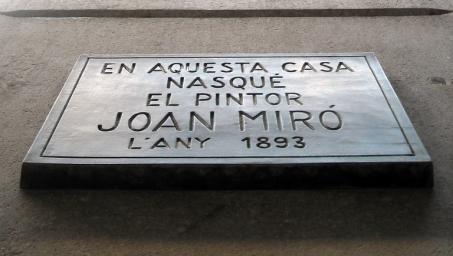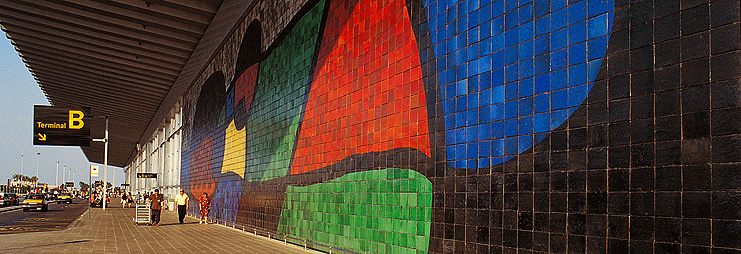It was in the Catalan metropolis of Barcelona that Miró was born, and it was here too that he took his first steps as an artist. Anyone visiting the city will quickly notice that Miró’s work is evident in many locations.
Passatge del Crèdit, 4. A magnificent house in a narrow alley in Barcelona Old Town. The Rambla, the city’s main artery, is close by, as is the cathedral. It was here that Joan Miró was born on April 20, 1893. A plaque on the wall marks the house as his birthplace. Miró’s father was a goldsmith and watchmaker, a businessman. He thought little of his son’s artistic ambitions. For a long time Miró’s father tried to encourage his son to pursue another career, but eventually, reluctantly, he allowed him to attend private art academies.

Passatge del Crèdit, Image via barcelonamovie.com
Miró found his way into art through two schools in Barcelona: one was the Escola de Belles Arts de Lotja, where Picasso also studied, and the other was the academy run by the artist Francesc Galí, who was known for his avant-garde approach, which made modernism more accessible to his students. It was in Miró’s home city that his career as a modern painter began, it was here that he came across the works of Marcel Duchamp, Fernand Léger and Juan Gris for the first time, and here that he had his first exhibition. Barcelona shaped the artist, although contact with the Parisian avant-garde a few years later undoubtedly influenced his work further.
Miró is omnipresent in Barcelona
In the city of Barcelona you continually come across signs of Miró, as the people of Barcelona keep the memory of their famous son alive. His is among the foremost names in the canon of Catalan national artists, and Miró himself left behind some of his most striking installations in the public spaces of the city of his birth. The first of these can be found directly at the airport: a wall ceramic from the year 1970 at Terminal B. Miró produced this in cooperation with Josep Llorens Artigas. One can immediately recognize the color fields typical of his later phase, clearly separated by broad, black lines. Similar in style is a floor mosaic made of cobblestones from 1976, which was laid out in the city center, on the Rambla itself. Another work in the public sphere is the enormous, more than 20-meter-high sculpture “Dona i ocell” (Woman and Bird), which was produced in 1982, the year of Miró’s death. The park it is located in now bears the artist’s name.

Mural by Joan Miró at Terminal B, airport of Barcelona, Image via barcelonacheckin.com

Joan Miro, Dona i ocell, Image via Wikimedia Commons
In 1919 Miró traveled to Paris, where he visited Picasso and stayed for some months. At the end of 1920 the young artist decided to live permanently by the Seine. Yet he retained a longing for his Catalan homeland. Since his family had moved to the town of Mont-roig del Camp near to Barcelona, Miró soon began commuting between the two locations. His major work “The Farm” from 1921/22 shows the family’s property in Mont-roig – as detailed as it is surreal. Miró himself talked about the “unreal reality” that would define the image. It was purchased, using money accumulated in various ways, by the writer Ernest Hemingway. The subsequently world-famous writer described the work thus: “It has in it all that you feel about Spain when you are there and all that you feel when you are away and cannot go there. No one else has been able to paint these two very opposing things.”
The Miró Museum tells the story of the avant-gardists
A place of pilgrimage for any of the artist’s fans visiting Barcelona is the Fundació Joan Miró on Montjuïc, the hill overlooking the Spanish metropolis. The best way to get there is on foot. Anyone starting out from Plaça d’Espanya can make a short detour to the famous pavilion that Ludwig Mies van der Rohe created for the 1929 World Exhibition. Then there are some stone steps to climb, which lead upwards through beautiful gardens. The Miró Museum almost appears as though the architect – Lluís Sert, a good friend of the artist – had designed it with Lego bricks: white cubes with rounded roofs are arranged in sequence, forming a whole. Everything is bright, playful, almost like a small fortress. The museum was opened while Miró was still alive. A large proportion of the works from the collection were left to the institution by the artist himself. More than 200 paintings, over 170 sculptures and 8,000 sketches have been accumulated.

The permanent exhibition shows the development of Miró, placing great emphasis on his early works, which were created in Barcelona. Small cabinets recount the artist’s development. Visitors can see early, undated pencil sketches of enchanting simplicity: ships, the sea, cypress trees, images of Palma de Mallorca. The paintings oriented on Fauvism or Cubism are also on display: buildings, streets and figures. However, it is also clear to see how quickly Miró embraced an abstract orientation, as is evident just a little later in the colorful surfaces that dominate his images. Much space is also given over to sculptures created by the artist. Some of these can be admired on the roof of the Fundació – also affording a view of the city. From the terrace, visitors can look down from Montjuïc onto a sea of roofs, a bustling metropolis. A sculpture has been placed against this panorama: the work “Lune, soleil et une étoile” (Moon, Sun and One Star), which dates from 1968. It appears – like the backdrop of the city – like a relic from another time.
Miró’s art lives on
No one can accuse the curators of the Fundació Joan Miró of resting on their laurels. Alongside the presentation of the collection and changing exhibitions of Miró’s work, there is always contemporary art on display too – frequently addressing the question of how contemporary artists make reference to Miró. Pipilotti Rist, Mona Hatoum and Roni Horn have exhibited here, for example, as have many regional artists, and there are also regular exhibitions of photographic art. Thus Miró’s work remains alive and relevant at the Fundació.



What matters is how you feel
Joan Miró took up a pen and wrote poems. On a great painter’s understanding of literature and poetry.

It is difficult to be Miró’s grandson
Joan Punyet Miró, grandson of Joan Miró, in conversation about the famous grandfather. On SCHIRN MAGAZINE

There is still paint clinging to the brushes
Fundació Pilar i Joan Miró on Majorca offers an insight into the work of an exceptional artist who valued simplicity just as much as the fantastical.